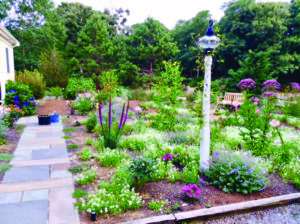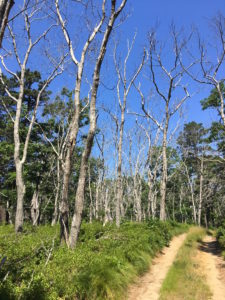The lawn. A tightly cropped, cleanly edged area of neat green. An outdoor carpet for lying on and looking at. A lawn is deeply ingrained in our culture as an extension of the home, a place where children grow up, where vows are exchanged, where memories are made. As a predictable, controlled monoculture, it is also a display of one’s acumen for maintenance.
Lawns came with the colonization of the continent by Europeans. With perennial grasses planted as a source of grazing for livestock, great rolling fields of green became a sign of a landscape tamed. By the mid 1700s and early 1800s, the lawn began to find its place as part of the American home. The concept of the lawn as we recognize it today was popularized by the Founding Fathers of the country.
While in France, Thomas Jefferson visited the Palace at Versailles. There he saw the “tapis vert,” or green carpet, that had been planted. He took this idea home and replicated it at Monticello. George Washington also had one planted at Mount Vernon. They were the pop icons of their day, so illustrations of their homes, surrounded by lawns, were circulated, and the style was emulated by those who could afford it.
Even now, lawns are expensive because they require a surprising number of inputs: water, fertilizer, weed and grub control, fungal and pathogen treatments, lime, aeration, and weekly mowing by fume-belching machines. There’s nothing quite like rolling about on a soft, warm, living carpet in the summer sun. And nothing quite like spending a thousand dollars a year to grow something as fast as possible only to cut it down just as quick. This is our country’s most widely cultivated crop, and it is one that cannot be eaten. Lawns are both wonderful and completely ridiculous. They have a place, but they are not the only option.
One alternative to consider for the space surrounding your home is planting a meadow of grasses, groundcovers, low perennials, and annuals. Pennsylvania sedge, prairie drop seed, little blue stems, and panicums can be grown alone, or paired with native perennials and groundcovers. This alternative lawn will provide a whole new layer of interest to your landscape, with flowers and foliage that change throughout the season. Native and naturalized plants are adapted to our soils and environmental conditions and require far less attention to thrive. They also provide habitats and food for wildlife. The birds, bees, and butterflies will be the guests entertained on this kind of lawn.
Another alternative is growing food instead of grass. Constructing raised beds and growing fruits and vegetables, even with installation and upkeep, will likely cost less than a lawn. In times that feel uncertain, developing a close relationship with food feels right. It appeals to our deepest instincts to provide that which is most essential.

A middle ground option is to simply relax the way your lawn is curated and maintained. A traditional lawn is a desert of greenness. Sowing clover into it is one great way to add variety. Clover produces flowers and is a nitrogen fixer, introducing nutrients into the soil. Or go farther and try a seed mix like the one called “alternative lawn mix,” available from American Meadows. It is a colorful palette of low-growing alyssum, clovers, daisies, wildflowers, fescues, and thyme, and it requires only a single mowing each year. There are many other mixes that can be seeded right into existing lawns to make them more worldly. In nearly all things, variety is good.
The perfect, unadulterated sea of green is a tradition we’ve accepted without questioning its validity or function. A lawn’s rightful place can be just where and how you really want it. I have always loved the dandelion, standing tall and proud, its bright yellow face to the sun in defiance against a backdrop of green. It’s an imperfection only if you believe it to be one.

